Sustainable Ecological Restoration Planning Strategies Based on Watershed Scenario Simulation: A Case Study of the Wuhan Metropolitan Area
Abstract
1. Introduction
- (1)
- What are the hydrological characteristics of secondary watersheds in the Wuhan Metropolitan Area during 2016–2020, and can the WEP-L model accurately reproduce the historical hydrological processes?
- (2)
- Under the RCP4.5 climate scenario, how will the key hydrological components—precipitation, evapotranspiration, runoff, and water resources—change by 2035?
- (3)
- How can the restoration zoning system derived from the simulation results support ecological restoration planning for the metropolitan area and facilitate the development of restoration strategies adaptive to multiple climate scenarios?
2. Materials and Methods
2.1. Study Area
2.2. Data and Processing
- (1)
- DEM Resampling
- (2)
- Soil Type Data Processing
- (3)
- Land Use Data Processing
- (4)
- Vegetation Coverage and Leaf Area Index Data Processing
- (5)
- Meteorological and Hydrological Data Processing
- (6)
- Water Use Data Processing
2.3. Methodology
2.3.1. WEP-L Model
- Surface depression storage layer
- Surface soil layer
- Middle soil layer
- Bottom soil layerwhere is the depression storage; is the maximum depression storage; and are the area ratios of high and low vegetation in the bare land-vegetation area; and are the water amounts from the high and low vegetation leaves to the surface; is gravitational drainage; is the water diffusion between the -th and ()-th soil layers due to capillary pressure; is the evaporation from depression storage; is the surface soil evaporation; is the vegetation transpiration (the first subscript 1 indicates high vegetation, 2 indicates low vegetation; the second subscript indicates soil layer number); is the interflow; is the hydraulic conductivity corresponding to the volumetric water content ; is the capillary pressure corresponding to the volumetric water content ; is the soil layer thickness; is the soil water storage; is the initial soil water storage in the surface layer. Subscripts 0, 1, 2, and 3 represent the depression storage layer, surface soil layer, second soil layer, and third soil layer, respectively. For detailed simulation process, see reference.
- (1)
- Relative Error
- (2)
- Correlation Coefficient
2.3.2. Scenario Setting
2.3.3. Ecological Restoration Zoning
3. Results
3.1. Calibration Results
3.2. Overall Simulation
3.2.1. Hydrological Pattern During the Historical Period (2016–2020)
3.2.2. Hydrological Simulation Results Under the 2035 Climate Scenario
- (1)
- Overall increase in precipitation and reduced spatial disparity
- (2)
- Widespread increase in evapotranspiration with a largely stable spatial pattern
- (3)
- Significant increase in runoff and a more moderate spatial gradient
- (4)
- Comprehensive increase in water resources and optimized spatial distribution
3.2.3. Hydrological Trend Analysis Across Secondary Watershed Units
3.3. Ecological Restoration Zoning in the Wuhan Metropolitan Area
4. Discussion
4.1. Summary of Key Findings
4.2. Research Innovations and Policy Implications
4.3. Research Limitations and Future Research Directions
5. Conclusions
Author Contributions
Funding
Institutional Review Board Statement
Informed Consent Statement
Data Availability Statement
Acknowledgments
Conflicts of Interest
References
- Li, D.; Yang, W.; Huang, R. The Multidimensional Differences and Driving Forces of Ecological Environment Resilience in China. Environ. Impact Assess. Rev. 2023, 98, 106954. [Google Scholar] [CrossRef]
- Xiao, R.; Lin, M.; Fei, X.; Li, Y.; Zhang, Z.; Meng, Q. Exploring the Interactive Coercing Relationship between Urbanization and Ecosystem Service Value in the Shanghai-Hangzhou Bay Metropolitan Region. J. Clean Prod. 2020, 253, 119803. [Google Scholar] [CrossRef]
- Chen, S.; Liu, X.; Yang, L.; Zhu, Z. Variations in Ecosystem Service Value and Its Driving Factors in the Nanjing Metropolitan Area of China. Forests 2023, 14, 113. [Google Scholar] [CrossRef]
- McGrane, S.J. Impacts of Urbanisation on Hydrological and Water Quality Dynamics, and Urban Water Management: A Review. Hydrol. Sci. J. 2016, 61, 2295–2311. [Google Scholar] [CrossRef]
- Zhou, Q.; Leng, G.; Su, J.; Ren, Y. Comparison of Urbanization and Climate Change Impacts on Urban Flood Volumes: Importance of Urban Planning and Drainage Adaptation. Sci. Total Environ. 2019, 658, 24–33. [Google Scholar] [CrossRef]
- Jefferson, A.J.; Bhaskar, A.S.; Hopkins, K.G.; Fanelli, R.; Avellaneda, P.M.; McMillan, S.K. Stormwater Management Network Effectiveness and Implications for Urban Watershed Function: A Critical Review. Hydrol. Process. 2017, 31, 4056–4080. [Google Scholar] [CrossRef]
- Qiu, J.; Shen, Z.; Leng, G.; Xie, H.; Hou, X.; Wei, G. Impacts of climate change on watershed systems and potential adaptation through BMPs in a drinking water source area. J. Hydrol. 2019, 573, 123–135. [Google Scholar] [CrossRef]
- Jia, Y.; Wang, H.; Zhou, Z.; Qiu, Y.; Luo, X.; Wang, J.; Qin, D. Development of the WEP-L Distributed Hydrological Model and Dynamic Assessment of Water Resources in the Yellow River Basin. J. Hydrol. 2006, 331, 606–629. [Google Scholar] [CrossRef]
- Khaki, M.; Ait-El-Fquih, B.; Hoteit, I. Calibrating Land Hydrological Models and Enhancing Their Forecasting Skills Using an Ensemble Kalman Filter with One-Step-Ahead Smoothing. J. Hydrol. 2020, 584, 124708. [Google Scholar] [CrossRef]
- Aznarez, C.; Jimeno-Sáez, P.; López-Ballesteros, A.; Pacheco, J.P.; Senent-Aparicio, J. Analysing the Impact of Climate Change on Hydrological Ecosystem Services in Laguna del Sauce (Uruguay) Using the SWAT Model and Remote Sensing Data. Remote Sens. 2021, 13, 2014. [Google Scholar] [CrossRef]
- Liang, W.; Bai, D.; Wang, F.; Fu, B.; Yan, J.; Wang, S.; Feng, M. Quantifying the Impacts of Climate Change and Ecological Restoration on Streamflow Changes Based on a Budyko Hydrological Model in China’s Loess Plateau. Water Resour. Res. 2015, 51, 6500–6519. [Google Scholar] [CrossRef]
- Xu, F.; Zhao, L.; Jia, Y.; Niu, C.; Liu, X.; Liu, H. Evaluation of Water Conservation Function of Beijiang River Basin in Nanling Mountains, China, Based on WEP-L Model. Ecol. Indic. 2022, 134, 108383. [Google Scholar] [CrossRef]
- Wang, X.; Dai, C.; Liu, G.; Yang, X.; Jing, J.; Ru, Q. Runoff Prediction in the Songhua River Basin Based on WEP Model. Hydrology 2025, 12, 266. [Google Scholar] [CrossRef]
- Abebe, B.K.; Zimale, F.A.; Gelaye, K.K.; Gashaw, T.; Dagnaw, E.G.; Adem, A.A. Application of Hydrological and Sediment Modeling with Limited Data in the Abbay (Upper Blue Nile) Basin, Ethiopia. Hydrology 2022, 9, 167. [Google Scholar] [CrossRef]
- Dorjsuren, B.; Yan, D.; Yuheng, Y.; Zemtsov, V.A.; Dong, N.; Gao, H.; Demberel, O. Advancing Hydrological Understanding in Cold Regions: Development and Application of the WEP Model for Lateral Flow Estimation in the Great Lakes Depression of Mongolia. Hydrol. Res. 2025, 56, 244–259. [Google Scholar] [CrossRef]
- Acosta, A.L.; d’Albertas, F.; de Souza Leite, M.; Saraiva, A.M.; Walter Metzger, J.P. Gaps and limitations in the use of restoration scenarios: A review. Restor. Ecol. 2018, 26, 1108–1119. [Google Scholar] [CrossRef]
- Possantti, I.; Barbedo, R.; Kronbauer, M.; Collischonn, W.; Marques, G. A comprehensive strategy for modeling watershed restoration priority areas under epistemic uncertainty: A case study in the Atlantic Forest, Brazil. J. Hydrol. 2023, 617, 129003. [Google Scholar] [CrossRef]
- Shen, J.; Gao, X.; He, W.; Sun, F.; Zhang, Z.; Kong, Y.; Wan, Z.; Zhang, X.; Li, Z.; Wang, J.; et al. Prospect Theory in an Evolutionary Game: Construction of Watershed Ecological Compensation System in Taihu Lake Basin. J. Clean Prod. 2021, 291, 125929. [Google Scholar] [CrossRef]
- Fu, Y.; Zhang, J.; Zhang, C.; Zang, W.; Guo, W.; Qian, Z.; Liu, L.; Zhao, J.; Feng, J. Payments for Ecosystem Services for Watershed Water Resource Allocations. J. Hydrol. 2018, 556, 689–700. [Google Scholar] [CrossRef]
- Alvarez, X.; Valero, E.; Santos, R.M.B.; Varandas, S.G.P.; Fernandes, L.F.S.; Pacheco, F.A.L. Anthropogenic Nutrients and Eutrophication in Multiple Land Use Watersheds: Best Management Practices and Policies for the Protection of Water Resources. Land Use Pol. 2017, 69, 1–11. [Google Scholar] [CrossRef]
- Zhang, M.; Peng, C.; Shu, J.; Lin, Y. Territorial Resilience of Metropolitan Regions: A Conceptual Framework, Recognition Methodologies and Planning Response—A Case Study of Wuhan Metropolitan Region. Int. J. Environ. Res. Public Health 2022, 19, 1914. [Google Scholar] [CrossRef]
- Xiao, Y.; Lan, G.; Ou, Y.; Zhang, L.; Xia, J. Impact of Urbanization on the Spatial and Temporal Evolution of the Water System Pattern: A Study of the Wuhan Metropolitan Area in China. Ecol. Indic. 2023, 153, 110408. [Google Scholar] [CrossRef]
- Wang, T.; Li, H.; Huang, Y. The Complex Ecological Network’s Resilience of the Wuhan Metropolitan Area. Ecol. Indic. 2021, 130, 108101. [Google Scholar] [CrossRef]
- National Geomatics Center of China. National Geospatial Information Resource Catalogue Service System; Ministry of Natural Resources of the People’s Republic of China: Beijing, China, 2020; Available online: http://www.ngcc.cn/ (accessed on 10 November 2025).
- Resource and Environment Science and Data Center, Chinese Academy of Sciences. Resource and Environmental Science Data Platform; Resource and Environment Science and Data Center, Chinese Academy of Sciences: Beijing, China, 2020; Available online: http://www.resdc.cn/ (accessed on 10 November 2025).
- National Meteorological Information Center, China Meteorological Administration. National Meteorological Information Center Data Service Platform; National Meteorological Information Center, China Meteorological Administration: Beijing, China, 2020; Available online: http://data.cma.cn/ (accessed on 10 November 2025).
- Ministry of Water Resources of the People’s Republic of China. China Hydrological Yearbook; China Water & Power Press: Beijing, China, 2020. [Google Scholar]
- Provincial Water Resources Departments. Local Water Resource Bulletins; Provincial Water Resources Departments: Beijing, China, 2020. [Google Scholar]
- Hubei Provincial Government. Extracted Based on the “Hubei Province Comprehensive Watershed Management and Coordinated Development Plan”; Hubei Provincial Government: Wuhan, China, 2020. [Google Scholar]
- Local Water Administration Departments at Various Levels. Reservoir Distribution Data; Local Water Administration Departments: Beijing, China, 2020. [Google Scholar]
- NASA. MODIS (Moderate Resolution Imaging Spectroradiometer) Data Portal; NASA Goddard Space Flight Center: Greenbelt, MD, USA, 2020. Available online: https://modis.gsfc.nasa.gov/ (accessed on 10 November 2025).
- Yuan, Z.; Yin, J.; Wei, M.; Yuan, Y. Spatio-Temporal Variations in the Temperature and Precipitation Extremes in the Yangtze River Basin, China during 1961–2020. Atmosphere 2021, 12, 1423. [Google Scholar] [CrossRef]
- Goodchild, M.F.; Longley, P.A.; Maguire, D.J.; Rhind, D.W. Geographic Information Systems and Science; John Wiley & Sons: Chichester, UK, 2005. [Google Scholar]
- Ding, M.; Liu, W.; Xiao, L.; Zhong, F.; Lu, N.; Zhang, J.; Wang, K. Construction and Optimization Strategy of Ecological Security Pattern in a Rapidly Urbanizing Region: A Case Study in Central-South China. Ecol. Indic. 2022, 136, 108604. [Google Scholar] [CrossRef]
- Yan, Z.; Zhou, Z.; Liu, J.; Han, Z.; Gao, G.; Jiang, X. Ensemble Projection of Runoff in a Large-Scale Basin: Modeling with a Global BMA Approach. Water Resour. Res. 2020, 56, e2019WR026134. [Google Scholar] [CrossRef]
- Qin, C.; Jia, Y.; Su, Z.; Zhou, Z.; Qiu, Y.; Suhui, S. Integrating Remote Sensing Information into a Distributed Hydrological Model for Improving Water Budget Predictions in Large-Scale Basins through Data Assimilation. Sensors 2008, 8, 4441–4465. [Google Scholar] [CrossRef]
- Xu, F.; Jia, Y.; Niu, C.; Sobkowiak, L.; Zhao, L. Evaluating Spatial Differences in the Contributions of Climate Variability and Human Activity to Runoff Change in the Haihe River Basin. Hydrol. Sci. J. 2021, 66, 2060–2073. [Google Scholar] [CrossRef]
- Du, J.; Jia, Y.; Hao, C.; Qiu, Y.; Niu, C.; Liu, H. Temporal and Spatial Changes of Blue Water and Green Water in the Taihang Mountain Region, China, in the Past 60 Years. Hydrol. Sci. J. 2019, 64, 2040–2056. [Google Scholar] [CrossRef]
- Zhang, Z.; Chen, Y.; Zhang, G.; Zhang, X. Simulation of Hydrological Processes in the Jing River Basin Based on the WEP Model. Water 2023, 15, 2989. [Google Scholar] [CrossRef]
- Qualls, R.J.; Crago, R.D. Graphical Interpretation of Wet Surface Evaporation Equations. Water Resour. Res. 2020, 56, e2019WR026766. [Google Scholar] [CrossRef]
- Pan, S.; Pan, N.; Tian, H.; Friedlingstein, P.; Sitch, S.; Shi, H.; Running, S.W. Evaluation of Global Terrestrial Evapotranspiration Using State-of-the-Art Approaches in Remote Sensing, Machine Learning and Land Surface Modeling. Hydrol. Earth Syst. Sci. 2020, 24, 1485–1509. [Google Scholar] [CrossRef]
- Song, X.; Lu, F.; Xiao, W.; Zhu, K.; Zhou, Y.; Xie, Z. Performance of 12 Reference Evapotranspiration Estimation Methods Compared with the Penman–Monteith Method and the Potential Influences in Northeast China. Meteorol. Appl. 2019, 26, 83–96. [Google Scholar] [CrossRef]
- Wang, J.; Chen, L. The Effect of Hillslope Geometry on Hortonian Rainfall-Infiltration-Runoff Processes. J. Hydrol. 2021, 594, 125962. [Google Scholar] [CrossRef]
- Singh, N.K.; Emanuel, R.E.; McGlynn, B.L.; Miniat, C.F. Soil Moisture Responses to Rainfall: Implications for Runoff Generation. Water Resour. Res. 2021, 57, e2020WR028827. [Google Scholar] [CrossRef]
- Pörtner, H.O.; Farrell, A.P. Physiology and climate change. Science 2008, 322, 690–692. [Google Scholar] [CrossRef] [PubMed]
- Grimm, N.B.; Faeth, S.H.; Golubiewski, N.E.; Redman, C.L.; Wu, J.; Bai, X.; Briggs, J.M. Global Change and the Ecology of Cities. Science 2008, 319, 756–760. [Google Scholar] [CrossRef]
- Intergovernmental Panel on Climate Change (IPCC). Climate Change 2014: Synthesis Report; IPCC: Geneva, Switzerland, 2014. [Google Scholar]
- Moss, R.H.; Edmonds, J.A.; Hibbard, K.A.; Manning, M.R.; Rose, S.K.; Al, E. The next Generation of Scenarios for Climate Change Research and Assessment. Nature 2010, 463, 747–756. [Google Scholar] [CrossRef]
- Thomson, A.M.; Calvin, K.V.; Smith, S.J.; Kyle, G.P.; Volke, A.; Patel, P.; Delgado-Arias, S.; Bond-Lamberty, B.; Wise, M.A.; Clarke, L.E.; et al. RCP4.5: A Pathway for Stabilization of Radiative Forcing by 2100. Clim. Change 2011, 109, 77–94. [Google Scholar] [CrossRef]
- Cheng, S.; Li, C.; Yue, Y. Characteristics of Temporal and Spatial Changes of Temperature and Precipitation in Central China from 1961 to 2020. Water Resour. Hydropower Technol. 2023, 54, 75–86. [Google Scholar]
- Cariboni, J.; Gatelli, D.; Liska, R.; Saltelli, A. The Role of Sensitivity Analysis in Ecological Modelling. Ecol. Model. 2007, 203, 167–182. [Google Scholar] [CrossRef]
- Hu, X.; Ma, C.; Huang, P.; Guo, X. Ecological Vulnerability Assessment Based on AHP-PSR Method and Analysis of Its Single Parameter Sensitivity and Spatial Autocorrelation for Ecological Protection? A Case of Weifang City, China. Ecol. Indic. 2021, 125, 107464. [Google Scholar] [CrossRef]
- Xing, L.; Hu, M.; Wang, Y. Integrating Ecosystem Services Value and Uncertainty into Regional Ecological Risk Assessment: A Case Study of Hubei Province, Central China. Sci. Total Environ. 2020, 740, 140126. [Google Scholar] [CrossRef] [PubMed]
- Peh, K.S.-H.; Balmford, A.; Field, R.H.; Lamb, A.; Birch, J.C.; Bradbury, R.B.; Brown, C.; Butchart, S.H.M.; Lester, M.; Morrison, R.; et al. Benefits and Costs of Ecological Restoration: Rapid Assessment of Changing Ecosystem Service Values at a UK Wetland. Ecol. Evol. 2014, 4, 3875–3886. [Google Scholar] [CrossRef] [PubMed]
- Yu, D.; Ding, T. Assessment on the Flow and Vulnerability of Water Footprint Network of Beijing City, China. J. Clean Prod. 2021, 293, 126126. [Google Scholar] [CrossRef]
- Nazar, M.S.N.; Asadolahi, Z.; Rabbani, F.; Abbaspour, K.C.C.; Sakieh, Y. Modeling the Integrated Effects of Landuse and Climate Change on the Hydrologic Response of Gorganroud Watershed in Iran. Theor. Appl. Climatol. 2023, 151, 1687–1707. [Google Scholar] [CrossRef]
- Fashae, O.A.; Ayorinde, H.A.; Olusola, A.O.; Obateru, R.O. Landuse and Surface Water Quality in an Emerging Urban City. Appl. Water Sci. 2019, 9, 25. [Google Scholar] [CrossRef]
- Ahn, S.R.; Kim, S.J. Assessment of Climate Change Impacts on the Future Hydrologic Cycle of the Han River Basin in South Korea Using a Grid-Based Distributed Model. Irrig. Drain. 2016, 65, 11–21. [Google Scholar] [CrossRef]
- Worku, G.; Teferi, E.; Bantider, A.; Dile, Y.T. Modelling Hydrological Processes under Climate Change Scenarios in the Jemma Sub-Basin of Upper Blue Nile Basin, Ethiopia. Clim. Risk Manag. 2021, 31, 100272. [Google Scholar] [CrossRef]
- Gosling, S.N.; Taylor, R.G.; Arnell, N.W.; Todd, M.C. A Comparative Analysis of Projected Impacts of Climate Change on River Runoff from Global and Catchment-Scale Hydrological Models. Hydrol. Earth Syst. Sci. 2011, 15, 279–294. [Google Scholar] [CrossRef]
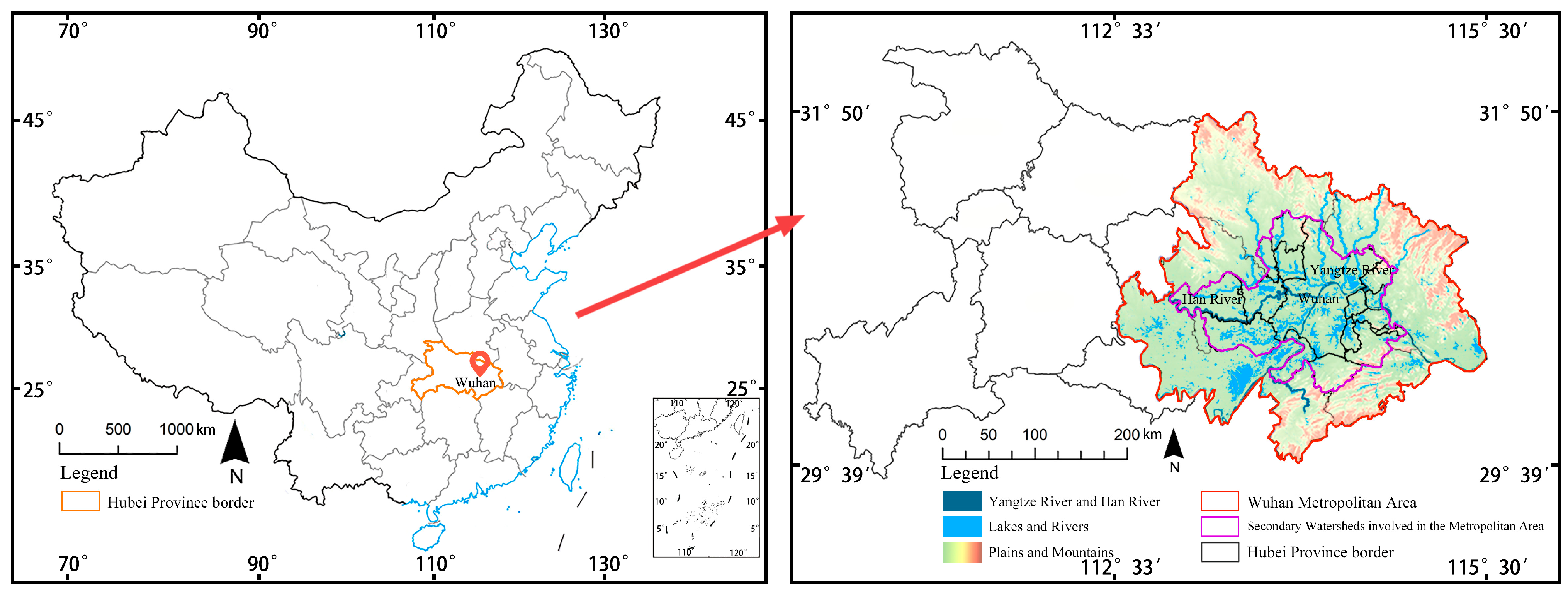
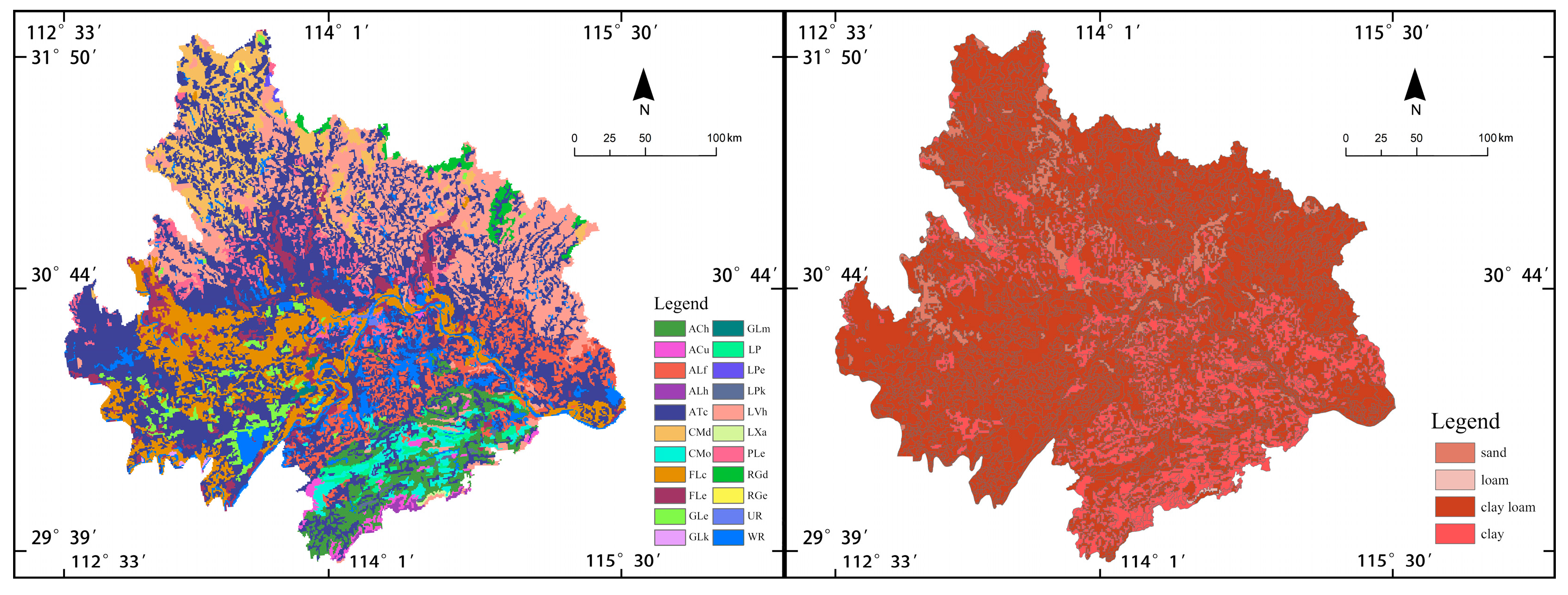
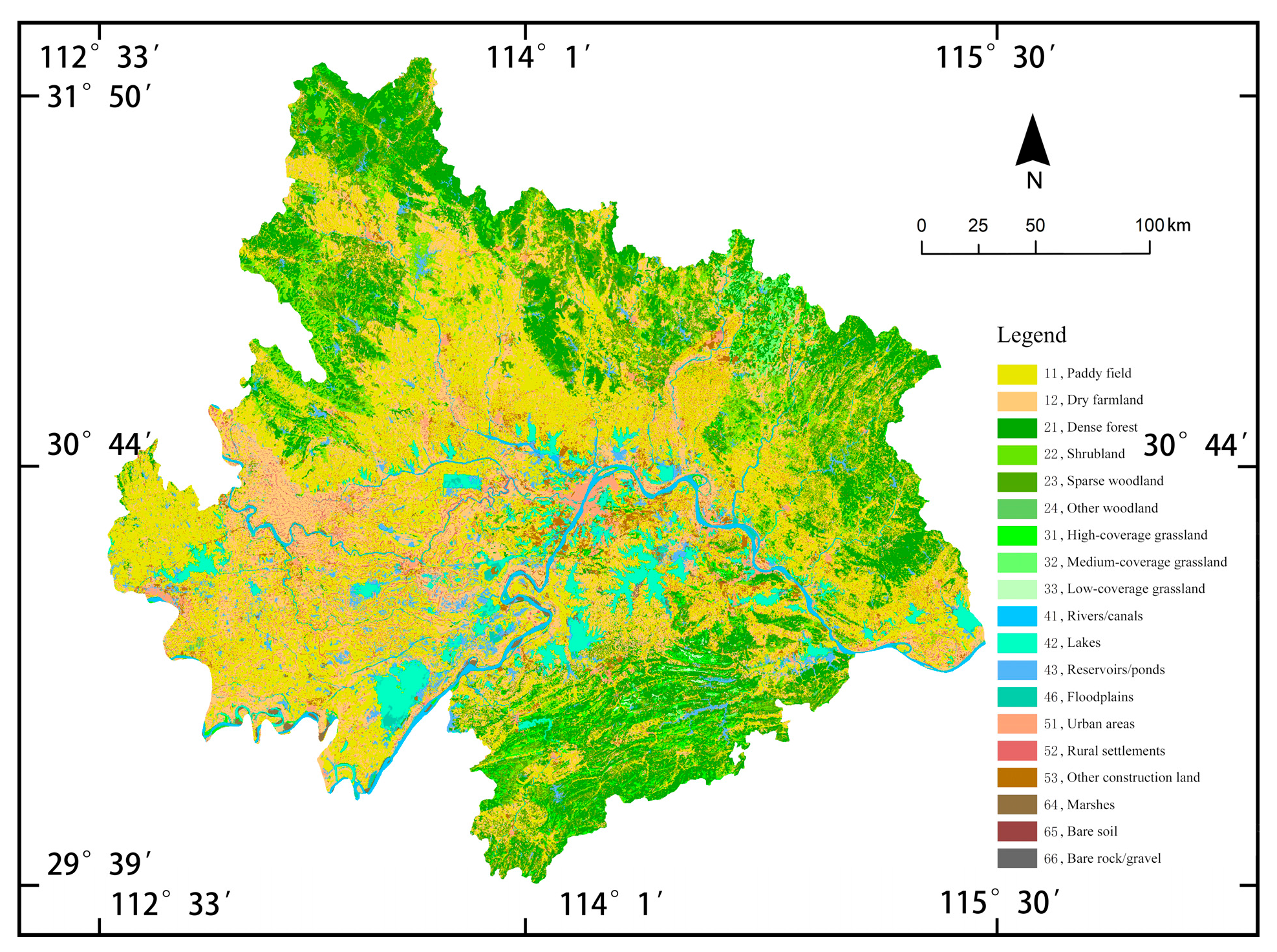
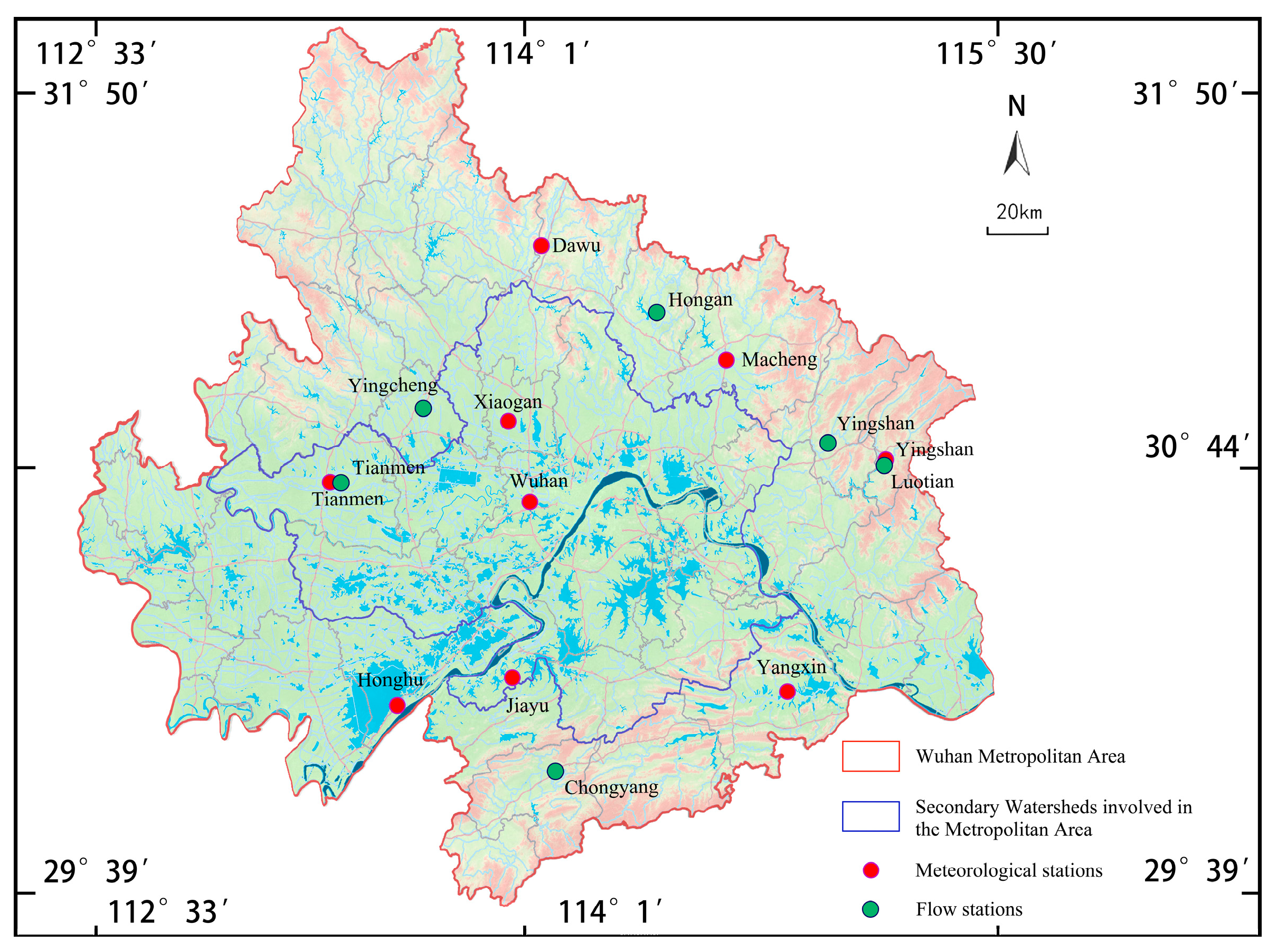
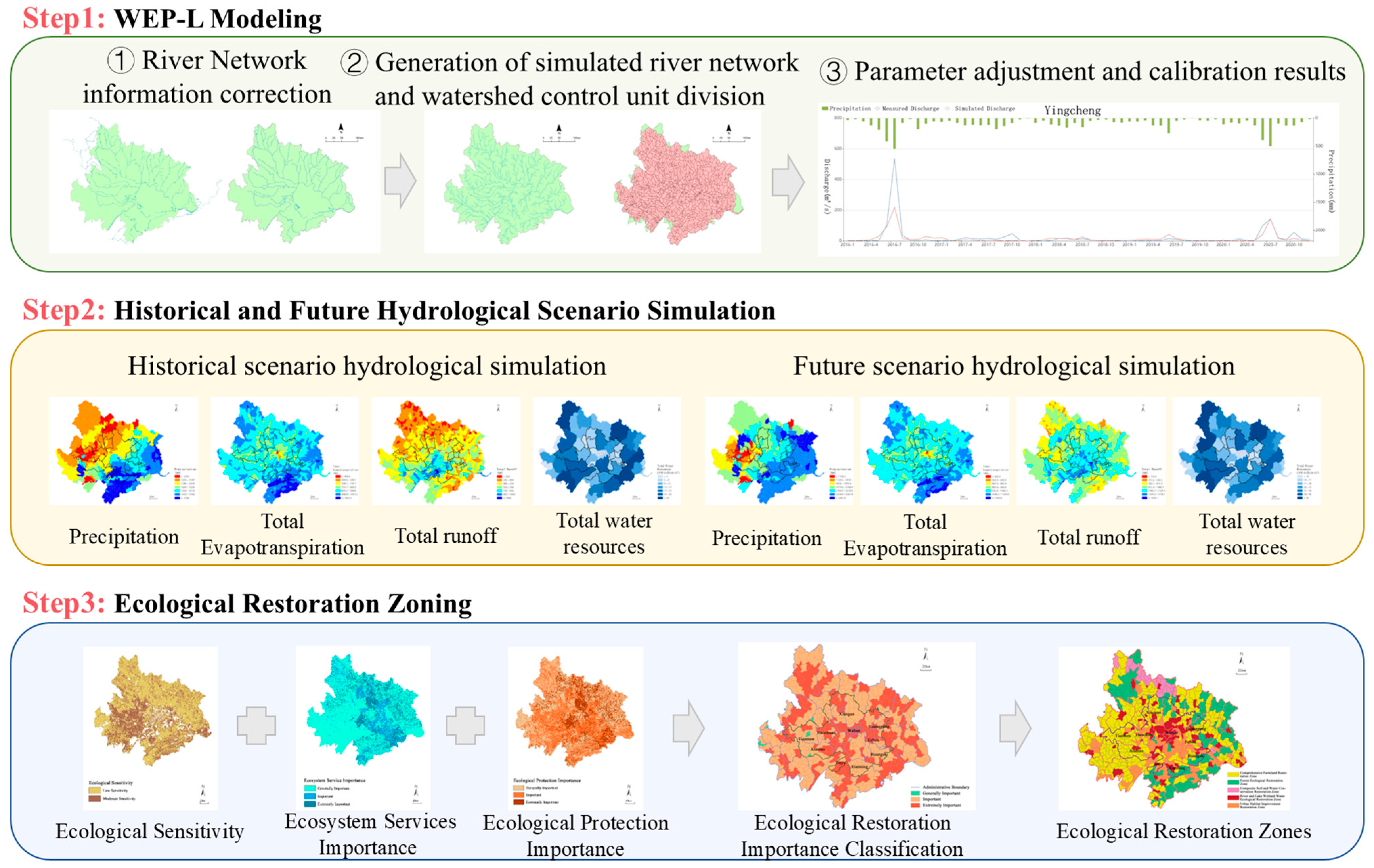

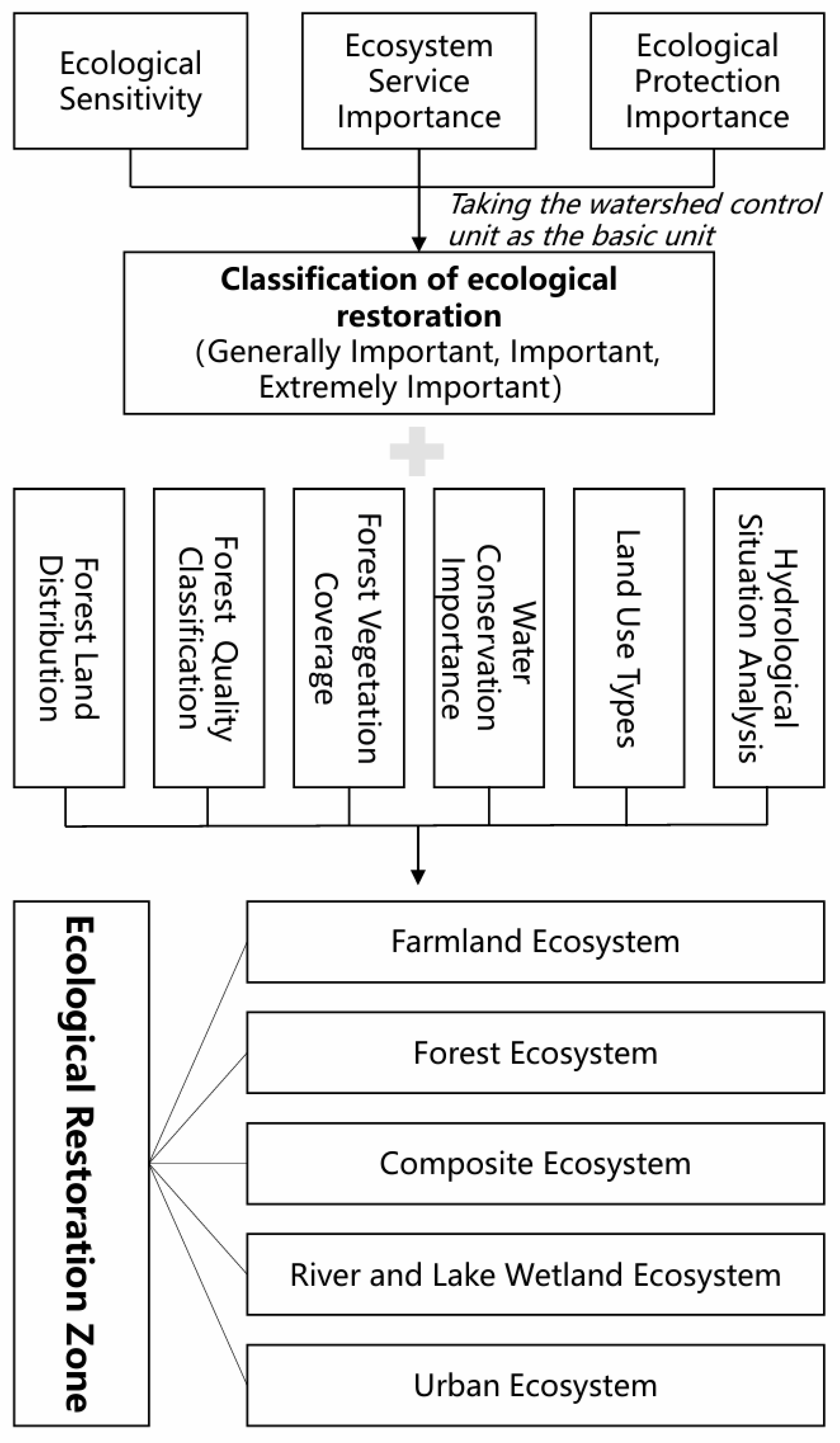

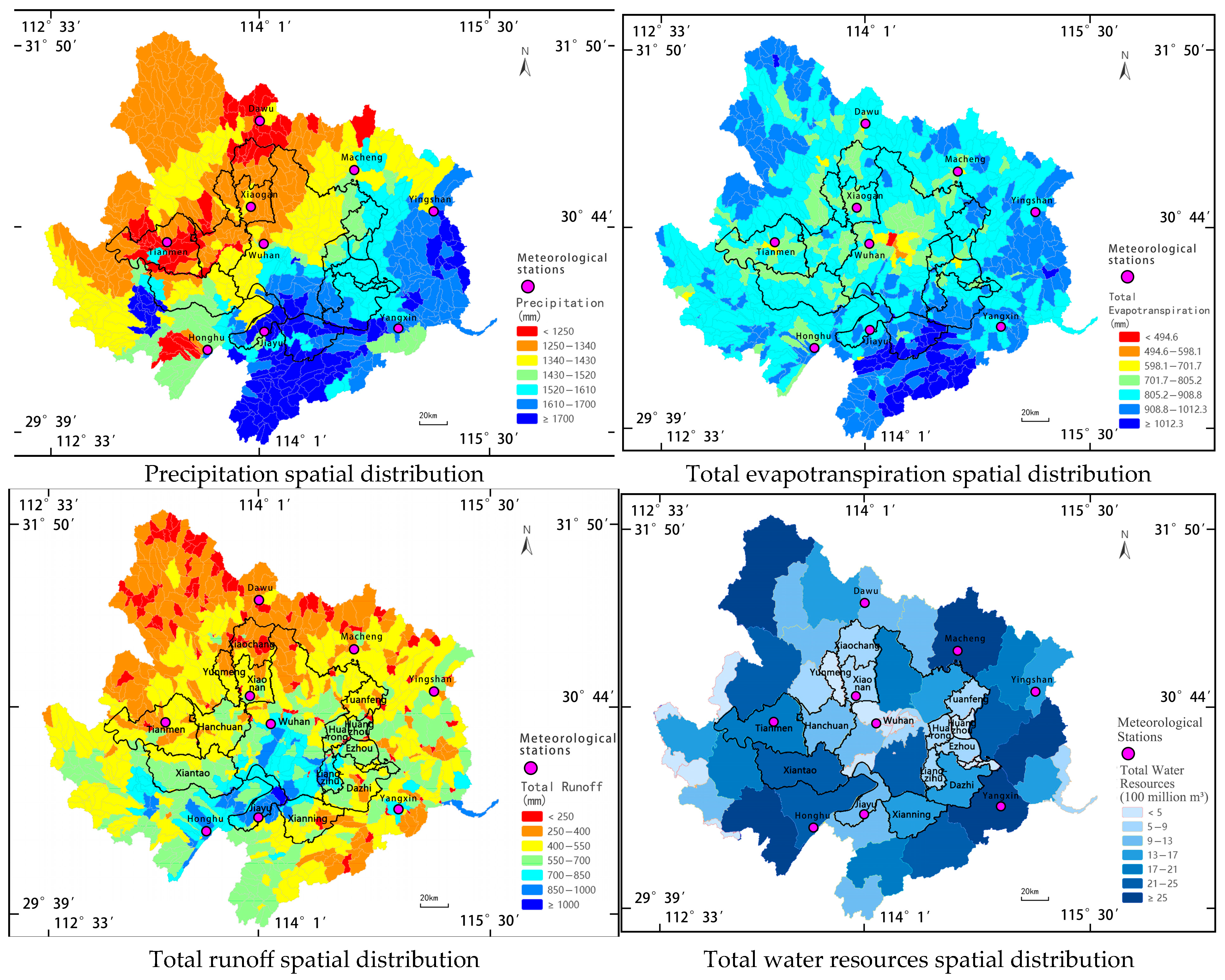

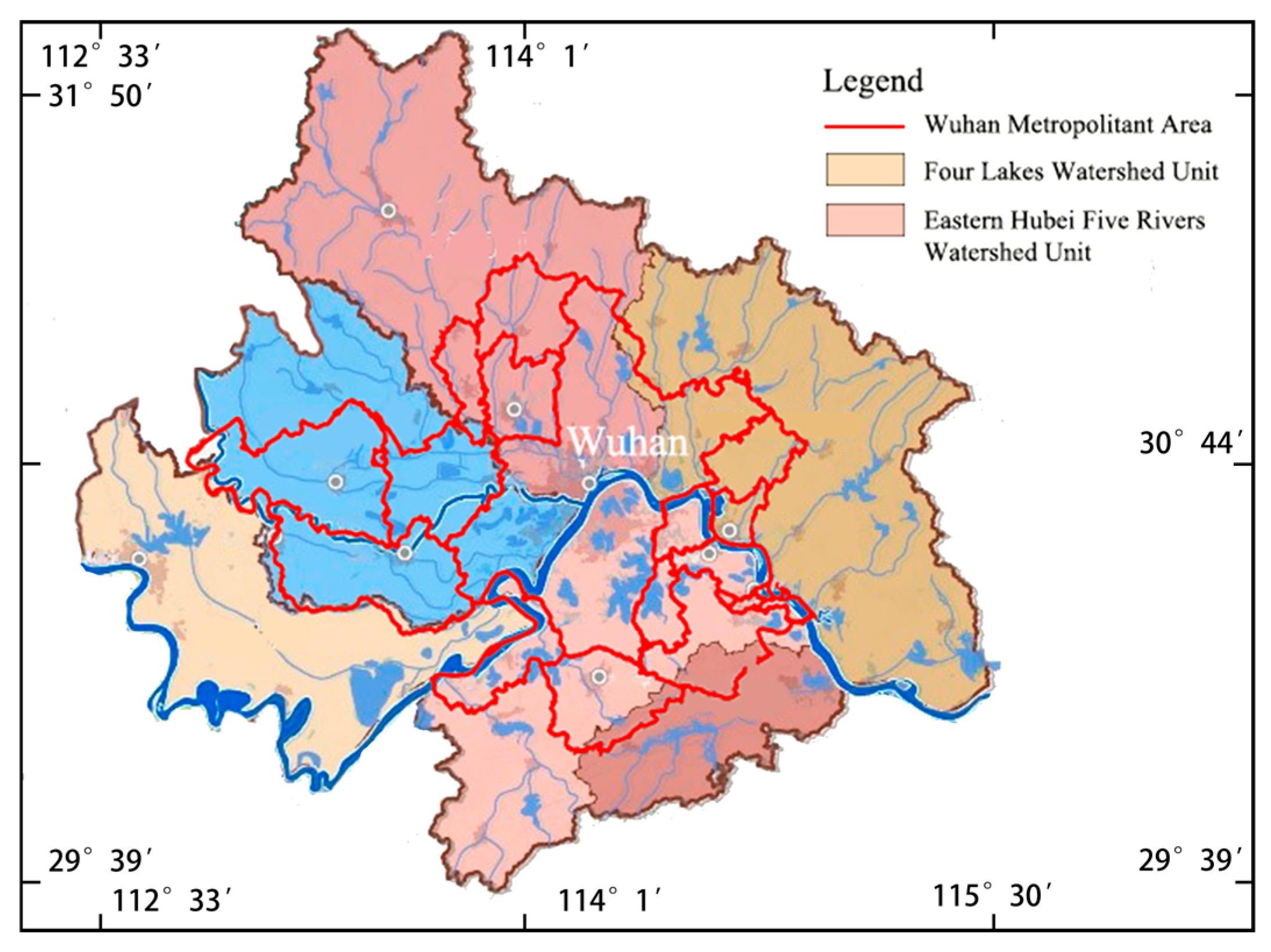



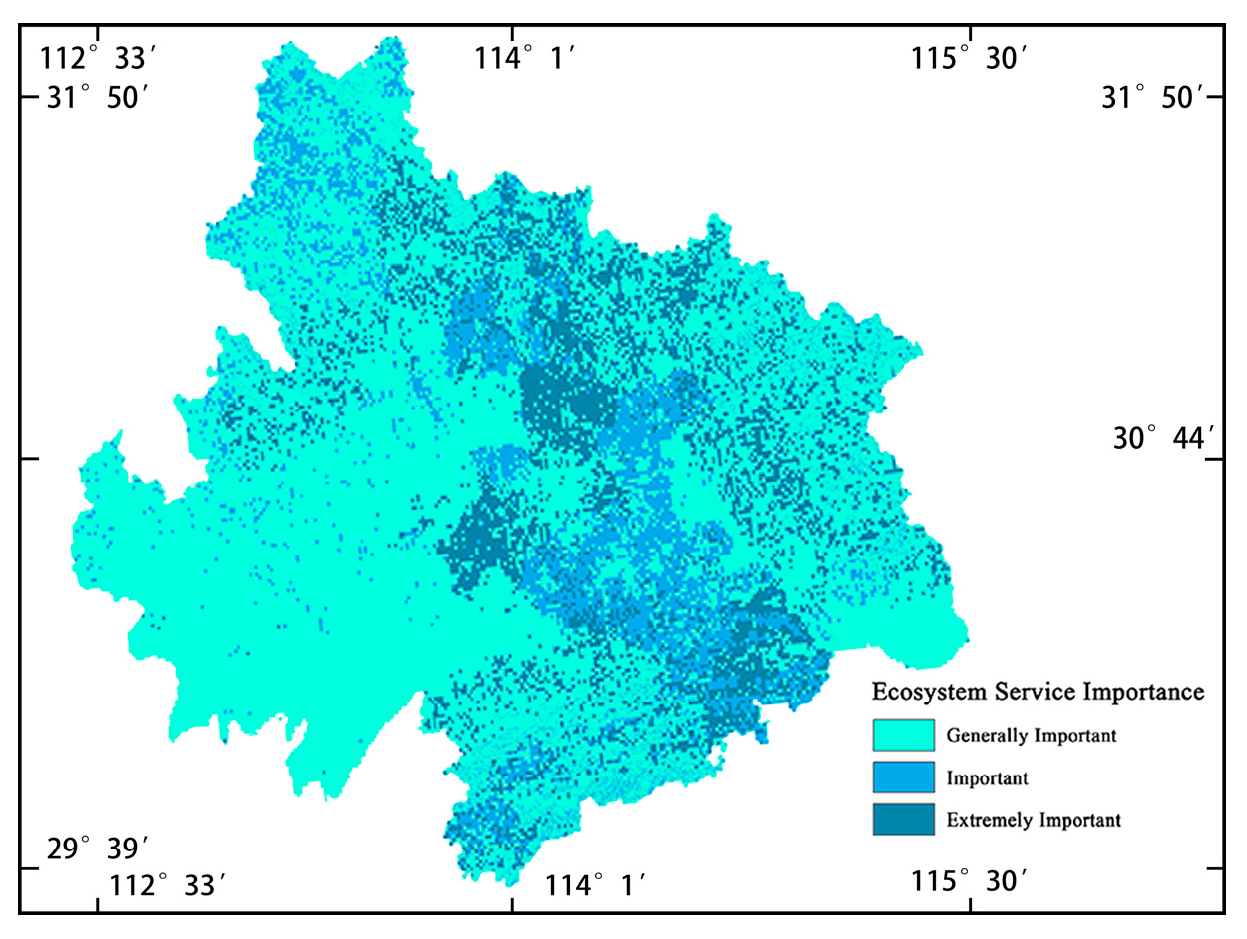
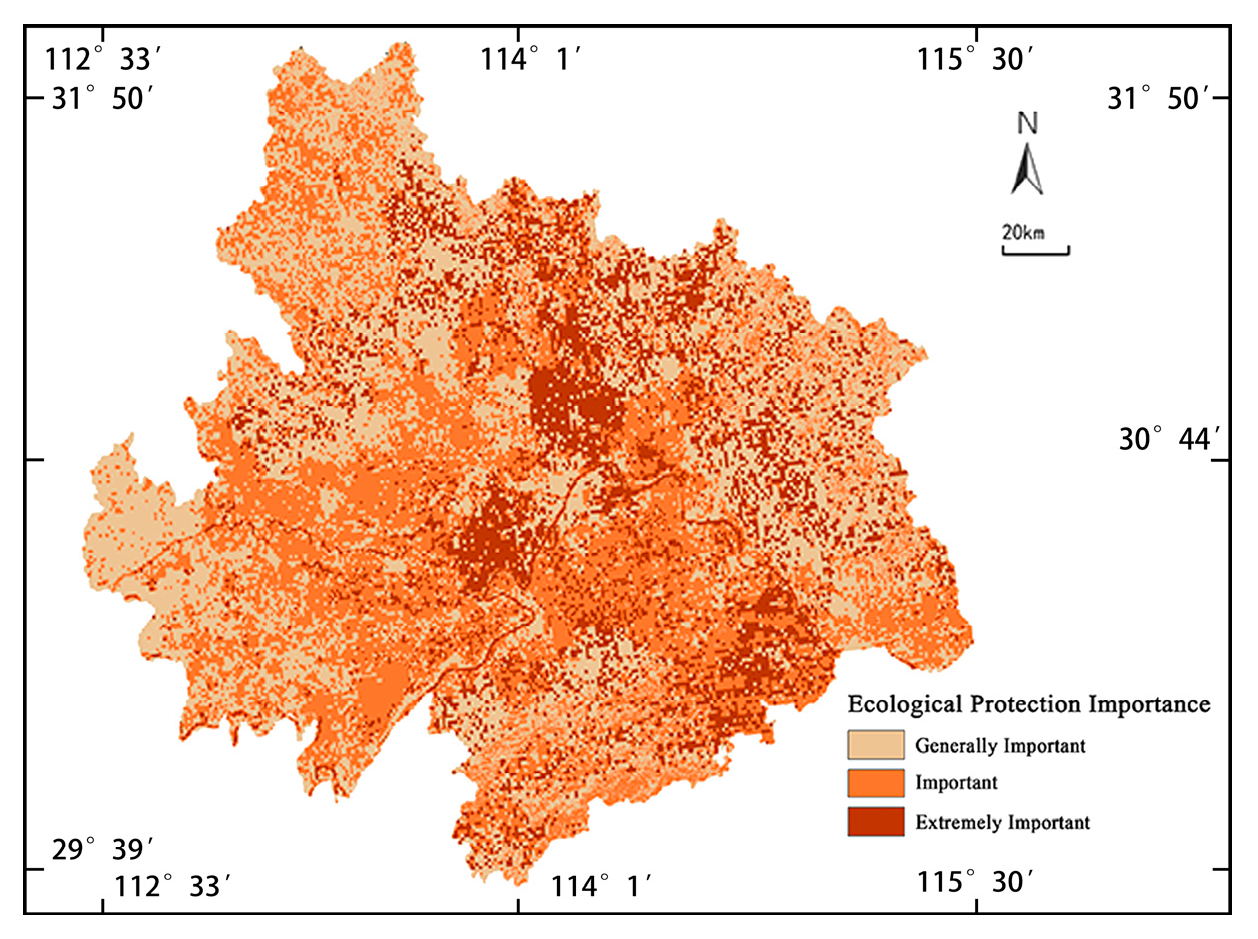
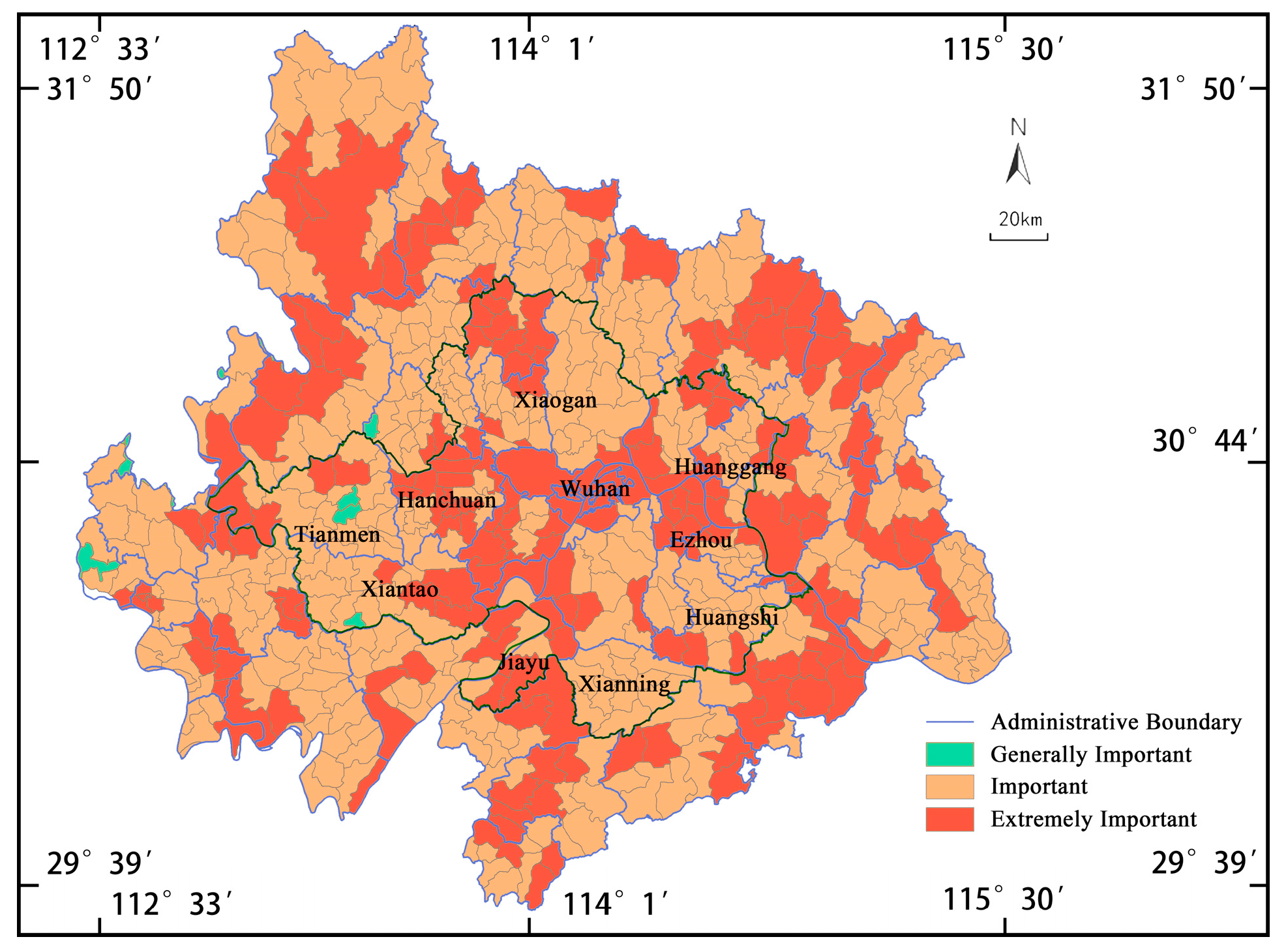
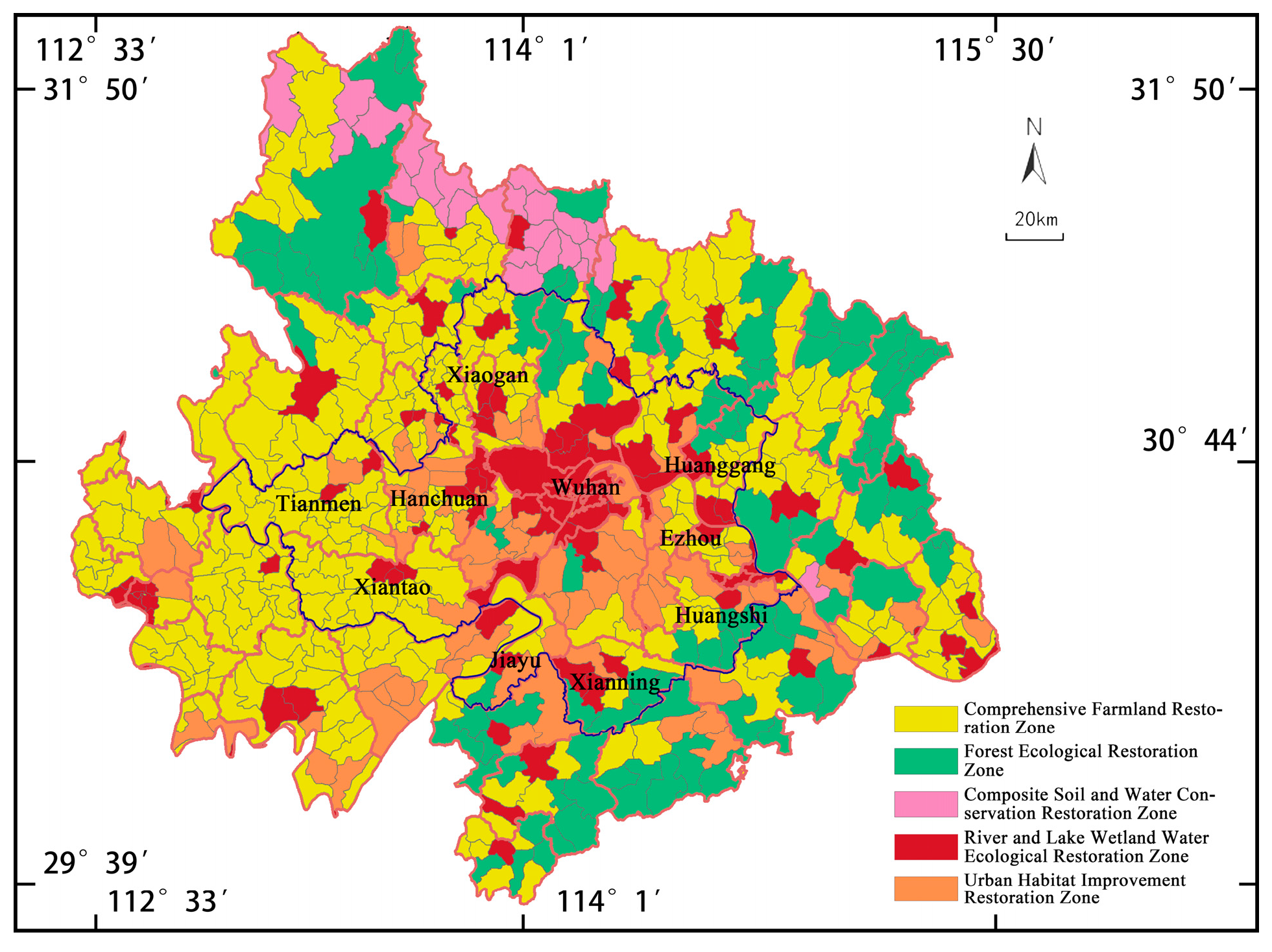
| Category | Name | Format | Time | Source |
|---|---|---|---|---|
| Geographic Information Data | Watershed Boundaries | Raster Data (30 m) | 2020 | Extracted based on the “Hubei Province Comprehensive Watershed Management and Coordinated Development Plan” [29], township-level administrative boundaries, and river system data |
| Administrative Divisions | Raster Data (30 m) | 2020 | National Geospatial Information Resource Catalog Service System [24] | |
| Digital Elevation Model (DEM) | Raster Data (30 m) | 2020 | Resource and Environmental Science Data Center of the Chinese Academy of Sciences [25] | |
| Flow Station Locations | Raster Data (30 m) | 2020 | “China Hydrological Yearbook” [27] | |
| River System Data | Raster Data (30 m) | 2020 | National Geospatial Information Resource Catalog Service System [24] | |
| Reservoir Distribution | Raster Data (30 m) | 2020 | Local Water Administration Departments at Various Levels [30] | |
| Land Use Data | Raster Data (30 m) | 2020 | Resource and Environmental Science Data Platform [25] | |
| Vegetation Leaf Area Index | Raster Data (500 m) | 2020 | https://modis.gsfc.nasa.gov [31] | |
| Vegetation Coverage | Raster Data (500 m) | 2020 | https://modis.gsfc.nasa.gov [31] | |
| Soil Type Data | Raster Data (1 km) | 2020 | Environmental and Resource Data Center of the Chinese Academy of Sciences [25] | |
| Meteorological Data | Station Information | CSV File | 2020 | the National Meteorological Information Center [26] |
| Precipitation Data | CSV File | 2016–2020 | the National Meteorological Information Center [26] | |
| Temperature Data | CSV File | 2016–2020 | the National Meteorological Information Center [26] | |
| Wind Speed Data | CSV File | 2016–2020 | the National Meteorological Information Center [26] | |
| Sunshine Duration Data | CSV File | 2016–2020 | the National Meteorological Information Center [26] | |
| Relative Humidity Data | CSV File | 2016–2020 | the National Meteorological Information Center [26] | |
| Hydrological Data | Observed Flow Data | CSV File | 2016–2020 | “China Hydrological Yearbook” [27] |
| Water Use Data | Agricultural Water Use Data | CSV File | 2016–2020 | Local Water Resource Bulletins [28] |
| Industrial and Domestic Water Use Data | CSV File | 2016–2020 | Local Water Resource Bulletins [28] |
| Station Name | Code | Longitude (E°) | Latitude (N°) | Elevation (m a.s.l.) |
|---|---|---|---|---|
| Dawu | 57395 | 114.116667 | 31.566667 | 74.9 |
| Macheng | 57399 | 114.95 | 31.133333 | 74.3 |
| Xiaogan | 57482 | 113.95 | 30.9 | 25.5 |
| Tianmen | 57483 | 113.133333 | 30.666667 | 31.9 |
| Wuhan | 57494 | 114.05 | 30.6 | 23.6 |
| Honghu | 57581 | 113.45 | 29.816667 | 27.4 |
| Jiayu | 57583 | 113.966667 | 29.916667 | 61.7 |
| Yingshan | 58402 | 115.666667 | 30.733333 | 123.8 |
| Yangxin | 58500 | 115.216667 | 29.9 | 57 |
| Station Name | Code | Longitude (E°) | Latitude (N°) |
|---|---|---|---|
| Hongan | 61610400 | 114.62 | 31.28 |
| Yingcheng | 62209400 | 113.55 | 30.95 |
| Yingshan | 61616000 | 115.4 | 30.8 |
| Luotian | 61617400 | 115.7 | 30.75 |
| Tianmen | 62206900 | 113.13 | 30.67 |
| Chongyang | 61703000 | 114.05 | 29.53 |
| Administrative Unit | Total Runoff (mm) | Total Water Resources (100 Million m3) |
|---|---|---|
| Wuhan | 14,838 | 81.54 |
| Xiaochang | 1824 | 8.78 |
| Xiaonan | 2217 | 8.55 |
| Yunmeng | 1023 | 4.83 |
| Hanchuan | 2649 | 12.04 |
| Tianmen | 2681 | 20.11 |
| Xiantao | 3194 | 22.66 |
| Jiayu | 3353 | 9.79 |
| Xianning | 2598 | 15.61 |
| Tuanfeng | 1112 | 7.77 |
| Huangzhou | 824 | 3.3 |
| Ezhou | 1087 | 6.68 |
| Huarong | 1142 | 5.61 |
| Liangzihu | 1321 | 5.9 |
| Dazhi | 2473 | 16.83 |
| Administrative Unit | Total Runoff (mm) | Total Water Resources (100 Million m3) |
|---|---|---|
| Wuhan | 18263 | 68.25 |
| Xiaochang | 2372 | 5.05 |
| Xiaonan | 2921 | 5.71 |
| Yunmeng | 1715 | 3.14 |
| Hanchuan | 3363 | 9.78 |
| Tianmen | 3529 | 18.92 |
| Xiantao | 4156 | 22.24 |
| Jiayu | 3997 | 11.97 |
| Xianning | 3002 | 14.92 |
| Tuanfeng | 1953 | 5.29 |
| Huangzhou | 1652 | 2.52 |
| Ezhou | 1973 | 5.71 |
| Huarong | 1846 | 4.14 |
| Liangzihu | 2169 | 5.94 |
| Dazhi | 3294 | 16.72 |
| Type | Ecological Restoration Zone | Watershed Dimension Control Requirements |
|---|---|---|
| Farmland Ecosystem | I—Comprehensive Farmland Restoration Zone | Focus on comprehensive management of watershed water resources. Implement scientific farmland water conservancy projects, including the planning, construction, and management of water conservancy facilities, to ensure the rational use and protection of farmland water resources. Simultaneously, take measures to reduce agricultural non-point source pollution, including reasonable fertilization and scientific pesticide use, to prevent negative impacts of agricultural activities on watershed water quality. |
| Forest Ecosystem | II—Forest Ecological Restoration Zone | Focus on maintaining and improving the hydrological environment. Strengthen forest protection, maintain the integrity of forest ecosystems, and ensure the functions of forests in water conservation and water quality purification. Concurrently, implement forest ecological projects, such as afforestation and protective forest construction, to promote the efficient operation of the hydrological cycle and maintain the stability of watershed water resources. |
| Composite Ecosystem | III—Composite Soil and Water Conservation Restoration Zone | Emphasize the organic combination of soil and water conservation measures with water resource management. Implement various soil and water conservation projects, including terrace construction, vegetation restoration, and slope covering, to reduce soil erosion, improve soil conservation, and ensure the reduction of surface runoff, maintaining the stability of watershed water quality. Additionally, strengthen the coordination between soil and water conservation measures and farmland water conservancy facilities to promote the comprehensive utilization of water resources. |
| River and Lake Wetland Ecosystem | IV—River and Lake Wetland Water Ecological Restoration Zone | Focus on the restoration and protection of aquatic ecosystems. Strengthen the ecological restoration of river and lake wetlands, including planting aquatic plants, restoring and protecting wetlands, to enhance the self-purification capacity of water bodies and improve the water quality environment. At the same time, strictly control pollutant discharge to protect the integrity of wetland and aquatic ecosystems and maintain the health of watershed water ecology. |
| Urban Ecosystem | V—Urban Habitat Improvement Restoration Zone | Emphasize the comprehensive management and utilization of urban water resources. Strengthen the protection and utilization of urban water resources, including promoting the construction of a water-saving society, building rainwater utilization facilities, and improving the urban water environment, to enhance the sustainable utilization of urban water resources. At the same time, strengthen urban water environment management, reduce pollutant discharge, improve urban water quality, and enhance the quality of the urban living environment. |
| Watershed Water Security | Watershed Water Resources | Watershed Water Environment | Watershed Water Landscape | |
|---|---|---|---|---|
| Eastern Hubei Five Rivers Watershed Unit | It is recommended to create green ecological corridors in the upstream river sections to restore river ecology, serve surrounding urban development, and provide shared urban space resources and natural carriers. | It is recommended to prioritize adjusting agricultural planting structures, develop water-saving disaster-resistant agriculture, and add pumping stations to supplement water shortages in the north. | Strengthen comprehensive management of small watersheds, return orchards to forests around water sources, and adopt enhanced sewage interception + decentralized retention mode in the southwest. | In sections of Wuhan and Ezhou, widen the river cross-sections according to flood requirements, mainly using greenways and boardwalks, combined with existing municipal roads to build a complete transportation system. Additionally, retention ponds and artificial wetlands will be added outside the flood cross-sections. |
| Four Lakes Watershed Unit | carry out flood control remediation while maintaining the current river course, by appropriately widening and raising embankments, revamping bank protection, dredging, and clearing obstacles to consolidate flood control goals. | build new pumping stations to interconnect regional reservoirs and channels, providing emergency water sources during droughts. | Strengthen the construction and management of farmland water conservancy facilities and promote water-saving irrigation techniques. Enhance source protection at water sources, manage surrounding land use, restrict non-agricultural activities and pollutant discharge to ensure the safety of drinking water sources. | At important water inlets on the east side, widen the river cross-sections according to flood requirements, and combine large lakes and flood detention areas to create leisure ecological seasonal landscapes, forming a new city waterfront landscape at the upper reaches of the Yangtze River. |
Disclaimer/Publisher’s Note: The statements, opinions and data contained in all publications are solely those of the individual author(s) and contributor(s) and not of MDPI and/or the editor(s). MDPI and/or the editor(s) disclaim responsibility for any injury to people or property resulting from any ideas, methods, instructions or products referred to in the content. |
© 2025 by the authors. Licensee MDPI, Basel, Switzerland. This article is an open access article distributed under the terms and conditions of the Creative Commons Attribution (CC BY) license (https://creativecommons.org/licenses/by/4.0/).
Share and Cite
Lin, Y.; Zhang, X.; Yu, X.; Li, K. Sustainable Ecological Restoration Planning Strategies Based on Watershed Scenario Simulation: A Case Study of the Wuhan Metropolitan Area. Sustainability 2025, 17, 10524. https://doi.org/10.3390/su172310524
Lin Y, Zhang X, Yu X, Li K. Sustainable Ecological Restoration Planning Strategies Based on Watershed Scenario Simulation: A Case Study of the Wuhan Metropolitan Area. Sustainability. 2025; 17(23):10524. https://doi.org/10.3390/su172310524
Chicago/Turabian StyleLin, Ying, Xian Zhang, Xiao Yu, and Kanglin Li. 2025. "Sustainable Ecological Restoration Planning Strategies Based on Watershed Scenario Simulation: A Case Study of the Wuhan Metropolitan Area" Sustainability 17, no. 23: 10524. https://doi.org/10.3390/su172310524
APA StyleLin, Y., Zhang, X., Yu, X., & Li, K. (2025). Sustainable Ecological Restoration Planning Strategies Based on Watershed Scenario Simulation: A Case Study of the Wuhan Metropolitan Area. Sustainability, 17(23), 10524. https://doi.org/10.3390/su172310524








